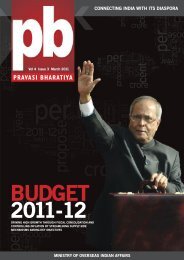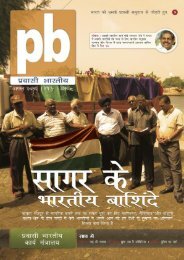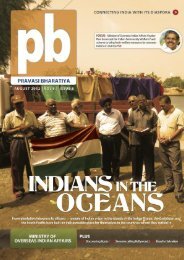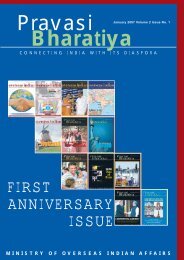annual report1-final.qxd - Overseas Indian
annual report1-final.qxd - Overseas Indian
annual report1-final.qxd - Overseas Indian
You also want an ePaper? Increase the reach of your titles
YUMPU automatically turns print PDFs into web optimized ePapers that Google loves.
Plenary Session 4<br />
its in their <strong>Indian</strong> operations while 84 percent of<br />
the foreign companies had plans for expansion of<br />
their <strong>Indian</strong> operations.<br />
He stated that, today, States had become key<br />
players in economic reforms through there were<br />
some growth disparities among <strong>Indian</strong> States.<br />
Therefore, state-level reforms held the key to a<br />
higher and sustainable growth trajectory and there<br />
was a need for benchmark performance against<br />
high growth states. Dr. Mitra asserted that for<br />
States, reforms in infrastructure, labour markets<br />
and governance were the key to success while fiscal<br />
solvency was equally crucial<br />
After Dr. Mitra’s presentation, Ahluwalia invited<br />
all Chief Ministers and state delegation heads for<br />
their presentations.<br />
Dr. Y.S.R. Reddy, Chief Minster, Andhra Pradesh<br />
started saying that the whole world was looking at<br />
India as a great opportunity for investments.<br />
‘India Everywhere’ was the key theme at Davos,<br />
where the World Economic Forum was meeting<br />
towards the end of January, 2006. The <strong>Indian</strong> economy<br />
was on a very strong footing, he said, stating<br />
that the fundamentals were very strong. Andhra<br />
Pradesh was the miniature version of India.<br />
“We are the largest south <strong>Indian</strong> State both in<br />
terms of population and area,” he said. He further<br />
outlined the profile of the State, which was rich in<br />
infrastructure and human resource. He mentioned<br />
that Andhra Pradesh was the leading agrarian<br />
State and offered a great opportunity for setting up<br />
of food and agro processing units. Other industries<br />
that could be set up in the State were automobile<br />
industries, electronic hardware, sugar, and leather.<br />
The State Government had announced a new<br />
Industrial Investment Policy for the period 2005-<br />
2010. Similarly the Government had also<br />
announced the IT Investment Policy and Food<br />
Processing Policy (2005-2010), he said.<br />
Bihar Chief Minister Nitish Kumar, at the outset,<br />
said that his mandate was to take Bihar on the road<br />
of development and assured the gathering that<br />
things should surely change in Bihar for the good<br />
of the State as well as the investor. The State’s<br />
potential would be fully tapped and for all this, he<br />
sought the overseas <strong>Indian</strong> support and participation.<br />
While talking of investment possibilities, he<br />
outlined that there was a great potential for investments<br />
in urban infrastructure, integrated city<br />
development and urban transport systems. He reiterated<br />
that Bihar was changing, and requested<br />
overseas <strong>Indian</strong>s to join the process of change. He<br />
quoted President Dr. A.P.J. Abdul Kalam: “If India<br />
is to succeed, Bihar must prosper.”<br />
Gujarat Chief Minister Narendra Modi talked<br />
about a “vibrant Gujarat” in which the focus was<br />
why Gujarat was the ‘numero uno’ State in India.<br />
He highlighted many aspects — from industry and<br />
economic freedom to energy — in which Gujarat<br />
was number one in this country. He highlighted<br />
that Gujarat was not in competition with <strong>Indian</strong><br />
States. Rather, he said Gujarat wished to compete<br />
with countries like Japan and China. He further<br />
talked about Gujarat’s assistance to Afghanistan in<br />
its rebuilding programme and also to Iran after the<br />
recent earthquake there. He talked about the tribal<br />
development programme, which was called<br />
Gujarat Pattern.<br />
Jammu & Kashmir (J&K) Chief Minister Ghulam<br />
Nabi Azad, in his speech, projected the profile of<br />
the State and how J&K was progressing mainly<br />
through tourism-related industries. He said that<br />
flow of tourists was increasing year by year and<br />
around 21,000 foreign visitors came to the Ladakh<br />
region last year. Jammu & Kashmir would be<br />
known like Switzerland in coming years, he said,<br />
adding that there were opportunities in tourism<br />
and horticulture for foreign investors. He invited<br />
them to become partners in the progress and development<br />
of J&K.<br />
Vilash Rao Deshmukh, Chief Minister,<br />
Maharastra, spoke about the commercial capital of<br />
India, Mumbai, and how it was integral to any kind<br />
of investment. He also asked investors to make a<br />
wise decision as all States were presented on a single<br />
platform. He suggested that investors could<br />
judge States on the basis of fiscal environment,<br />
investment policies, infrastructure and human<br />
resource. He further asked FICCI to conduct a<br />
study to see how much of investment had come to<br />
India in the last four years and how much had been<br />
contributed by the investor due to this particular<br />
16
















![flaxkiqj feuh izoklh Hkkjrh; fnol] vDVwcj 9&11 - Overseas Indian](https://img.yumpu.com/43977040/1/184x260/flaxkiqj-feuh-izoklh-hkkjrh-fnol-vdvwcj-911-overseas-indian.jpg?quality=85)
